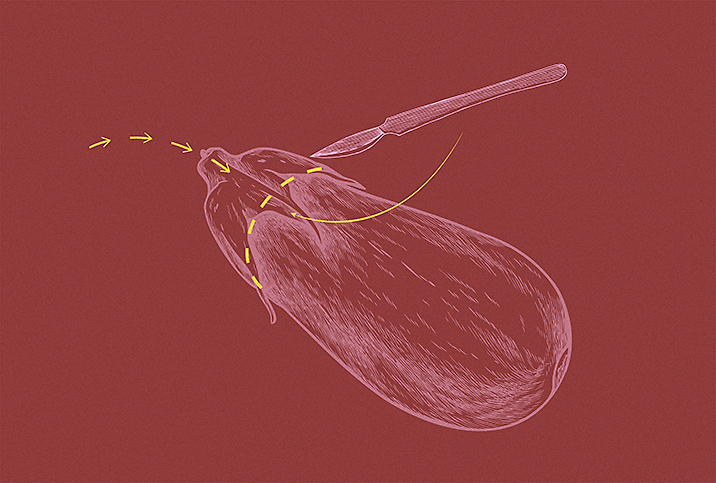Here's What You Can Expect During a Circumcision Procedure

Ask anyone, hypothetically, "Which spot on your body would you least like to have a sharp object slice into?" Most people would probably say the genitals. Yet one of the most common and routine surgeries performed around the world is circumcision, which involves just that.
It's a procedure people have been performing for thousands of years for various religious and cultural traditions. (Recent research has shown that being circumcised may result in a decreased risk for certain infections.)
What is circumcision, what are its origins and why do we do it? Perhaps most important to some people, what happens during a circumcision procedure?
What is circumcision?
Circumcision is the surgical removal of the foreskin that typically covers the tip of the penis at birth. The surgery is usually—but not always—performed shortly after birth. It originates from an ancient, ritualized practice with deep ties to a number of religious and ethnic groups around the world.
The practice is strongly associated with Judaism in Western cultures, but it is most widespread among Muslims. It has been practiced in Pacific Islander and sub-Saharan African communities; Mayan and Aztec cultures; and Aboriginal communities in Australia.
While circumcision has roots in cultural practices, today, it's also associated with health benefits in the form of a lowered risk of certain infections. Specifically, circumcision may reduce the risk of developing urinary tract infections (UTIs) and contracting HIV and other sexually transmitted infections (STIs), such as syphilis and gonorrhea.
Circumcision as practiced in Western medicine is a routine, low-risk procedure for both infants and adults.
Uncircumcised older children and men who develop certain conditions involving the foreskin undergo a circumcision procedure to alleviate the problem. Adult and older teen circumcision for aesthetic reasons is becoming more common.
Most of the time, however, the surgical procedure is performed on baby boys shortly after birth.
"Outside of the newborn period—and people have different cutoffs, 10 pounds, 12 pounds—the size of the baby is really determinant," said Amanda North, M.D., an expert in pediatric urology at the Children's Hospital at Montefiore in the Bronx in New York City. "When you're doing a newborn circumcision, the baby is generally strapped down. In most places, local anesthesia is given, but if the baby is more than 10 or 12 pounds, they tend to move. And you really don't want to take a sharp object to a baby's private parts when they're moving."
The circumcision procedure
In the United States and Judaic culture, the type of circumcision most frequently performed is complete circumcision. In this procedure, the entire foreskin is removed.
However, there is some variation in how much foreskin is removed across other traditions. Some people have only part of the foreskin removed, for instance, while other traditions keep the foreskin but snip the frenulum, the thin strip of skin that connects the underside of the head to the shaft.
Circumcision as practiced in Western medicine is a routine, low-risk procedure for both infants and adults. It may be performed by a pediatrician, family doctor, surgeon, urologist or a religious figure trained in it.
When the procedure is performed on infants, the child is placed on their back with their arms and legs restrained. An anesthetic topical cream or injection is applied to reduce discomfort, and surgeons often give infants a sucrose mixture called SweetEase, a nonpharmacological way to calm the baby and reduce pain and discomfort.
After the area is sterilized, depending on the preference and expertise of the person performing the procedure, various devices might be used:
- Gomco clamp. Developed almost 90 years ago but still in widespread use today, this device has a steel bell that protects the penis head during the procedure.
- Plastibell device. This disposable plastic device is designed to clamp the foreskin and cut off the blood supply for seven to 10 days until it falls off.
- Mogen clamp. The Mogen clamp has 2.5-millimeter blades and is commonly used by mohels in Jewish circumcision ceremonies. The primary disadvantage is that it doesn't offer protection for the glans.
"There are a number of clamp devices, but it's kind of a user's preference," North said. "A lot of people use the Gomco, some people use a Plastibell, but when you're a surgeon, you try to pick whatever technique is going to result in the fewest phone calls. The Plastibell device crushes the skin, and then it falls off at home over time. But sometimes they don't come off, so it leads to more parental concern and more visits back to the office. So I think it's not most people's choice."
During adult circumcisions, the patient is likely to be under general anesthesia or sedated. Once a local anesthetic has been injected or applied topically, the surgeon proceeds using their method of choice.
"In the operating room, there are a variety of techniques," North explained. "But most people do what we call a sleeve circumcision: We remove the foreskin as a sleeve of tissue, and that's done with surgical instruments. Some people use a scalpel. I tend to use an electric cautery device to make my incision because I think there's less bleeding and it looks just as good, but it takes less time to control the bleeding."
Once the foreskin is removed, the surgeon usually puts in several sutures and uses surgical glue to seal the incision.
North said some surgeons perform what's called "sutureless circumcision," but her preference is to put in a minimum of four sutures in infants, depending on how well the skin lines up and if there is any leakage. More sutures could be used for older boys.
Every surgeon has their preferences for post-op care, but for North, a healthy dollop of an antibiotic cream such as Neosporin or petroleum jelly is applied to help prevent drying and scarring. Then the area is bandaged with an elastic sleeve added around the outside to hold it in place for the first few days. After that, the dressing can be removed.
Conclusions
Regardless of the reasons behind the surgery, circumcision is a simple procedure that's performed quickly and relatively painlessly.
There are some groups that believe circumcising infants is a human rights violation, as the child has no choice in the process. There is also debate as to whether or not circumcision affects sexual pleasure.
However, adult circumcision has become more common, and whether you choose to have your child circumcised or decide to get a circumcision yourself later in life, the procedure remains routine and low risk.


















